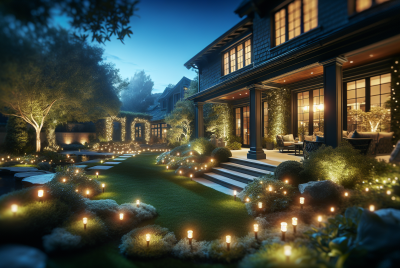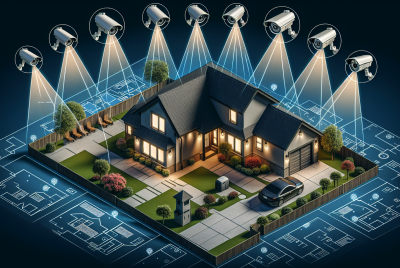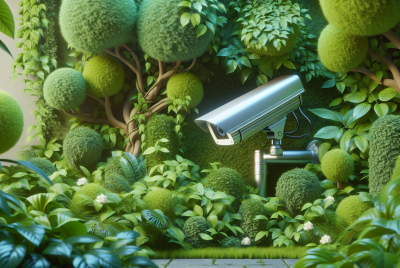How To Choose The Best Outdoor Security Lighting For Your Home
When it comes to keeping your home safe and secure, outdoor security lighting plays a crucial role. But with so many options to choose from, finding the best one for your home can be a daunting task. Luckily, we’ve got you covered. In this article, you will discover helpful tips and considerations that will guide you in selecting the perfect outdoor security lighting to keep your home protected and give you peace of mind. From motion sensor lights to smart lighting systems, we will help you make an informed decision for your home’s security needs.
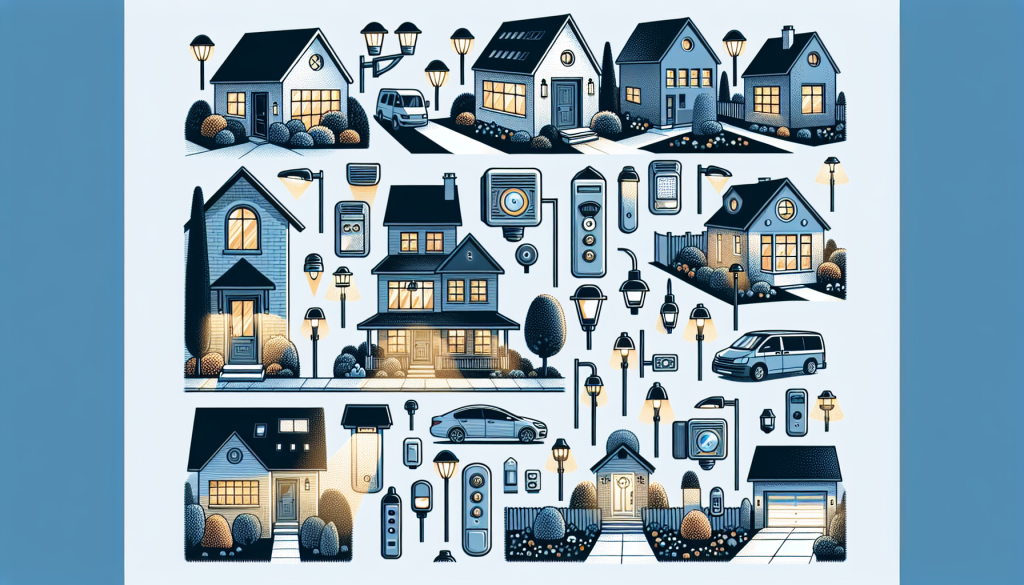
Types of Outdoor Security Lighting
Motion-Activated Lights
Motion-activated lights are a popular choice for outdoor security lighting. These lights are equipped with sensors that detect movement, automatically turning on when someone enters the area. This type of lighting is an effective deterrent for potential intruders, as it surprises them with a sudden burst of brightness. Motion-activated lights are commonly used at entryways, driveways, and other high-traffic areas. They not only enhance security but also provide convenience by lighting your way as you arrive home in the dark.
Floodlights
Floodlights are powerful lights that emit a broad beam of light, illuminating a large area. These lights are commonly used to brighten up yards, parking lots, and other outdoor spaces. Floodlights are an effective choice for outdoor security lighting, as their intensity can deter intruders and provide increased visibility. They can be used in conjunction with motion sensors to activate when movement is detected, effectively scaring away potential unwanted visitors.
Pathway Lights
Pathway lights are low-level lights that are installed along walkways, driveways, and garden paths. These lights provide added safety and enhance the aesthetics of your outdoor space. While pathway lights may not be as bright or powerful as other security lighting options, they still contribute to the overall security of your home by illuminating potential hazards and deterring trespassers. Pathway lights are available in various styles and designs, allowing you to choose the ones that best suit your personal taste and home’s aesthetic.
LED Lights
LED lights have gained popularity in recent years due to their energy efficiency and long lifespan. LED outdoor security lights are available in various types, including motion-activated lights, floodlights, and pathway lights. LED lights produce bright, clear light without consuming a significant amount of energy. They are a cost-effective and environmentally friendly option for outdoor security lighting. Additionally, LED lights are durable and require minimal maintenance, making them a convenient choice for homeowners.
Considerations for Choosing Outdoor Security Lighting
Brightness
When choosing outdoor security lighting, one of the most important factors to consider is the brightness of the lights. The brightness is typically measured in lumens, which indicates the amount of light emitted by a source. Higher lumen values mean a brighter light. It’s crucial to determine the level of brightness required for your outdoor space. Areas with high foot traffic or potential security risks may require brighter lights to ensure maximum visibility and deter intruders.
Coverage Area
The coverage area of outdoor security lighting refers to the space that the lights can effectively illuminate. It’s essential to consider the size of the area you want to secure and choose lights that can adequately cover that space. For motion-activated lights, the coverage area depends on the angle and range of motion of the sensor. Floodlights should be selected based on their spread and intensity, ensuring they can sufficiently light up a large area. Pathway lights have a specific illumination range, so you should consider the spacing and placement to cover your desired pathway effectively.
Power Source
Outdoor security lights can be powered by various sources, each with its advantages and drawbacks. Hardwired lighting is connected to your home’s electrical system and provides a consistent power supply. solar-powered lighting relies on solar panels to convert sunlight into energy, making it a sustainable and cost-effective option. Battery-powered lighting offers flexibility and can be easily installed in any desired location. Consider the accessibility of power sources in your outdoor space and choose the option that best suits your needs and preferences.
Durability
Since outdoor security lighting is subjected to various weather conditions, it’s crucial to select lights that are durable and built to withstand the elements. Look for lights that are weather resistant and can handle rain, snow, and extreme temperatures without malfunctioning. The quality of materials used in the construction of the lights is also essential in ensuring their durability. Additionally, check for an IP (Ingress Protection) rating, which indicates how well the lights are protected against dust and water. Opting for lights with a higher IP rating provides increased protection against environmental factors.
Factors to Evaluate Before Making a Purchase
Budget
Before purchasing outdoor security lighting, it’s essential to determine your budget. Consider how much you are willing to spend on the lights, installation, and maintenance. Setting a realistic spending range will help you narrow down your options and ensure you make a value-driven purchase. Remember to balance your budget with the quality and features you desire in the lights, as investing in reliable and long-lasting security lighting is crucial for the safety of your home.
Installation
Consider whether you are comfortable with DIY installation or if you prefer to hire professionals for the job. DIY installation allows you to save on installation costs but requires time, effort, and a basic understanding of electrical systems. Hiring professionals ensures proper installation and saves you from potential safety hazards. Evaluate your skills, the complexity of the installation process, and your willingness to invest in professional help to make an informed decision.
Maintenance
Outdoor security lighting requires regular maintenance to ensure optimal performance and longevity. Consider the maintenance requirements of different lighting options before making a purchase. LED lights, for example, require minimal maintenance and have a long lifespan, making them a low-maintenance choice. Solar-powered lights may require occasional cleaning of the solar panels, while battery-powered lights may require regular battery replacements. Assess your willingness to perform maintenance tasks or opt for lights that require less attention.
Integration with Other Security Systems
If you have an existing security system or plan to install additional security features, consider the compatibility of your chosen outdoor security lighting with these systems. For example, if you have surveillance cameras, ensure that the lights can be integrated to work in conjunction with the cameras. This integration can enhance the overall effectiveness of your security measures and provide a comprehensive solution for safeguarding your home. Additionally, consider if the lights are compatible with smart home systems, allowing you to control them remotely and increase convenience.
Assessing Brightness
Lumens vs. Watts
When assessing the brightness of outdoor security lighting, it’s essential to understand the difference between lumens and watts. Watts indicate the power consumption of a light, while lumens indicate the brightness it emits. In the past, watts were used as a primary measure of brightness, but with advancements in technology, lumens have become the standard unit. LED lights, for example, can produce high lumen values whilst consuming fewer watts compared to traditional incandescent lights. Therefore, when comparing lights, focus on the lumen value to determine their brightness.
Determining the Required Brightness for Your Space
To determine the required brightness for your outdoor space, consider its purpose and potential security risks. Areas with high foot traffic, such as driveways or entryways, may require brighter lights to ensure visibility and deter unwanted intruders. Consider the dimensions of the area and the level of illumination you desire. Additionally, evaluate the surrounding environment, such as nearby streetlights, and adjust your lighting choices accordingly. By considering these factors, you can choose outdoor security lighting that provides the appropriate level of brightness for your specific needs.
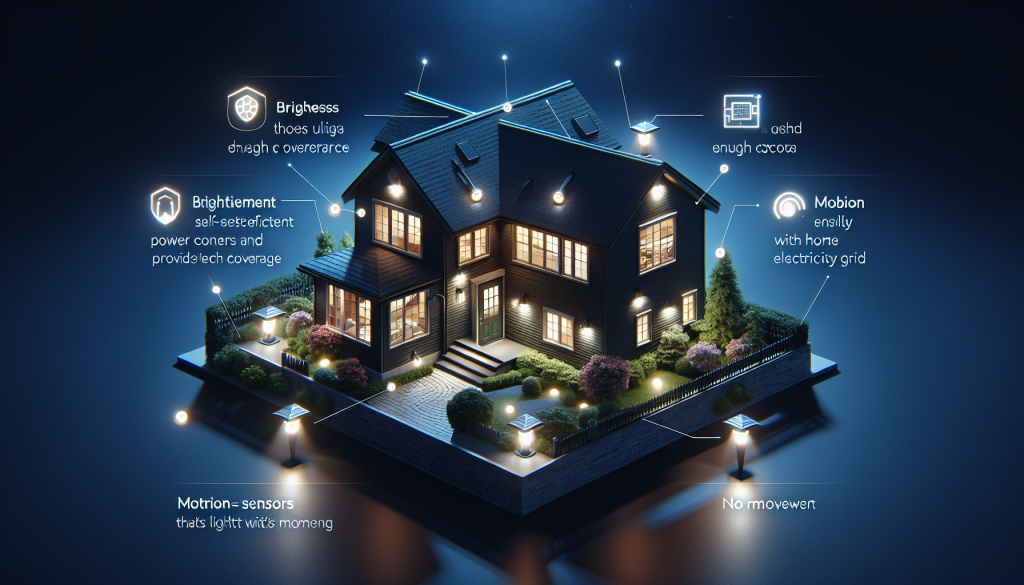
Determining Coverage Area
Angles and Range of Motion for Motion-Activated Lights
Motion-activated lights have sensors that detect movement and trigger the lights to turn on. When assessing the coverage area of these lights, consider the angles and range of motion of the sensor. Choose lights that have sensors with adjustable angles to ensure optimal coverage. Additionally, consider the range at which the sensors can detect motion to make sure the lights are activated at the desired distance. By selecting motion-activated lights that cover the appropriate angles and range, you can effectively secure the designated areas of your outdoor space.
Spread and Intensity of Floodlights
Floodlights are designed to provide wide coverage and intense illumination. When determining the coverage area of floodlights, consider the spread and intensity of the light they emit. Lights with a wider spread can cover larger areas, ensuring even distribution of light. The intensity of the light should be sufficient to provide the desired level of security and visibility. Evaluate the wattage or lumen values of the floodlights to determine their spread and intensity capabilities. By choosing floodlights that meet your coverage needs, you can effectively light up a large outdoor space.
Illumination Range of Pathway Lights
Pathway lights are primarily used to illuminate walkways, driveways, and garden paths. When considering the coverage area of pathway lights, evaluate their illumination range. Pathway lights typically have a specific range at which they can effectively illuminate the surrounding area. Consider the spacing and placement of the lights to ensure proper coverage of the desired path. Additionally, assess the brightness of the pathway lights to ensure they provide sufficient visibility and security. By selecting pathway lights that meet your coverage requirements, you can enhance the safety and aesthetics of your outdoor space.
Exploring Power Source Options
Hardwired Lighting
Hardwired lighting is directly connected to your home’s electrical system and requires professional installation. It provides a consistent power supply, ensuring reliable operation of the lights. Hardwired lighting is suitable for areas where electrical outlets are readily accessible, such as near the home’s exterior walls. While the initial installation cost of hardwired lighting may be higher compared to other options, it offers a long-term, dependable power source for your outdoor security lights.
Solar-Powered Lighting
Solar-powered lighting relies on solar panels to convert sunlight into energy, eliminating the need for an external power source. This option is environmentally friendly and highly cost-effective in the long run, as it does not incur electricity bills. Solar-powered lights are easy to install, as they do not require any wiring and can be placed in optimal locations to harness maximum sunlight. However, their effectiveness may vary depending on the amount of sunlight available in your area. Assess the solar exposure in your outdoor space before choosing this power source option.
Battery-Powered Lighting
Battery-powered lighting offers flexibility in terms of installation and power source. These lights operate on replaceable or rechargeable batteries, allowing you to place them anywhere without the need for electrical wiring. Battery-powered lights are easy to install since they require minimal setup. However, they may require regular battery replacements or recharging, depending on the battery type and usage. Consider the cost and convenience factors when opting for battery-powered lighting, as ongoing maintenance may be required to ensure continuous operation.
Considering Durability
Weather Resistance
Outdoor security lighting is exposed to various weather conditions, including rain, snow, and extreme temperatures. It’s crucial to choose lights that are weather resistant and can withstand these elements without compromising their performance. Look for lights that are specifically designed for outdoor use and have appropriate seals and gaskets to protect against moisture and environmental hazards. Lights with rust-proof and corrosion-resistant materials are also ideal for ensuring durability in all weather conditions.
Material Quality
The quality of materials used in the construction of outdoor security lighting directly impacts their durability. Opt for lights made from high-quality materials, such as stainless steel or aluminum, that are known for their resistance to rust and decay. Lights with durable lenses, such as tempered glass or impact-resistant plastic, can withstand potential impacts and maintain their functionality. By choosing lights with superior material quality, you can ensure their longevity, even in harsh outdoor environments.
IP Rating
The IP (Ingress Protection) rating of outdoor security lighting determines its level of protection against dust and water. The IP rating consists of two numbers, the first indicating solids protection and the second indicating liquids protection. For example, an IP65 rating means the light is dust tight and protected against low-pressure water jets from any direction. A higher IP rating translates to better protection against environmental factors. Consider the specific IP rating that suits your outdoor environment to ensure your lights are adequately protected and can withstand whatever nature throws their way.
Setting Your Budget
Determining a Reasonable Spending Range
When setting a budget for outdoor security lighting, it’s crucial to take into account the cost of the lights themselves, installation, and potential maintenance expenses. Consider the number of lights you need, their quality, and the features you desire. Research different options to get a sense of their price ranges and determine what you are comfortable spending. It’s important to strike a balance between your budget and the quality of the lights, as investing in reliable and durable security lighting is essential for the long-term safety of your home.
Considering Long-Term Costs
While it’s important to consider the upfront cost of outdoor security lighting, it’s equally important to evaluate the long-term costs associated with maintenance and energy consumption. LED lights, for example, have a higher initial cost but offer significant energy savings over their lifespan. Consider the potential savings in electricity bills and replacement costs over time when choosing between different lighting options. Assess the estimated lifespan of the lights, as longer-lasting lights can minimize ongoing maintenance and replacement expenses. By considering the long-term costs, you can make a more informed decision about your investment in outdoor security lighting.
Installation Methods
DIY Installation
DIY installation of outdoor security lighting can be a rewarding option for those who enjoy hands-on projects and have a basic understanding of electrical systems. It allows you to save on installation costs and gives you control over the placement and setup of the lights. However, it’s essential to proceed with caution and follow all safety guidelines. DIY installation may require tools and equipment, so ensure you have the necessary resources before starting the project. If you choose DIY installation, familiarize yourself with the installation instructions provided by the manufacturer and double-check your electrical connections to ensure a proper and safe installation.
Professional Installation
Professional installation ensures that your outdoor security lighting is properly installed and meets all safety standards. Hiring professionals not only saves you time and effort but also minimizes the risk of installation mistakes or accidents. Professionals have the experience and expertise to handle electrical connections, ensuring the lights are correctly wired and grounded. They can also recommend the best placement for optimal performance and coverage. If you are not confident in your DIY skills or prefer a hassle-free installation process, consider hiring professionals to ensure a seamless and professional setup of your outdoor security lighting.
Integration with Other Security Systems
Compatibility with Surveillance Cameras
If you have surveillance cameras installed or plan to incorporate them into your home security system, it’s important to choose outdoor security lighting that is compatible with these cameras. Integration between the lights and cameras can enhance the overall effectiveness of your security measures. Consider lights that can be synchronized with the cameras, allowing them to activate together when motion is detected. This coordination provides a more comprehensive view of the area and increases the chances of capturing relevant footage. Consult with security professionals or manufacturers to ensure compatibility and seamless integration.
Smart Home Integration
Many homeowners are embracing smart home technology to enhance security and convenience. If you have a smart home system in place, consider outdoor security lighting that can be integrated with your existing setup. Smart lighting allows you to control the lights remotely through smartphone apps or voice commands, providing flexibility and convenience. Check for compatibility with popular smart home platforms and ensure the lights can be seamlessly integrated without the need for additional devices or complex configurations. Smart home integration elevates your outdoor security lighting system to a new level of automation and control.
Choosing the best outdoor security lighting for your home involves considering various factors such as brightness, coverage area, power source, durability, budget, installation, and integration with other security systems. By evaluating these aspects, you can make an informed decision and select the lighting options that meet your specific needs and ensure the safety and security of your outdoor spaces. Remember that outdoor security lighting is an investment in the protection of your home and loved ones, so prioritize quality, reliability, and convenience when making your selection.


